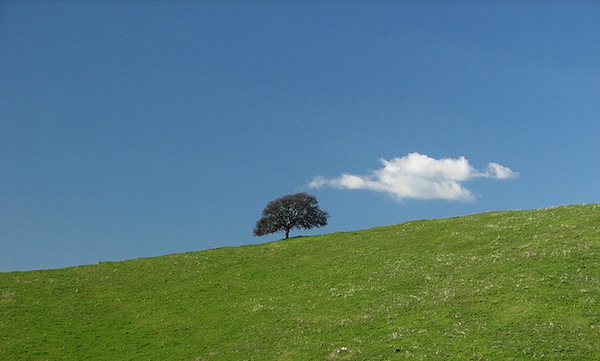
David Nowak is at it again. The tireless ecologist and his frequent collaborator Eric Greenfield have given us another comprehensive snapshot of urban forests in the United States. Nowak has published numerous studies on urban trees, one of which I’ve covered previously. But that study—which discovered that some cities are leafier than their pre-urban states—takes a longer view and paints a different picture. In this new study, Nowak and Greenfield focus on the more recent past, the 2000s, and find that 17 of the 20 cities they surveyed had significantly fewer trees than just five years earlier. Sixteen became more developed, too, with an increase in impervious surfaces like roadways, parking lots, rooftops, and sidewalks. Taken together, these findings suggest that cities across the U.S. are steadily defoliating.
In this most recent study, Nowak and Greenfield turned to a favorite tool of mine for evaluating forest cover—aerial photographs. For each city, Nowak and Greenfield found a pair of images taken three to six years apart. They scattered a minimum of 1,000 points across each city’s photo pair and manually classified them into eight categories: trees and shrubs, grass and herbaceous cover, bare soil, water, and three classes of impervious surfaces (buildings, roads, and other). They were accurate to within a few percent in every class.¹ Nowak and Greenfield also compared their subset of 20 cities to other large cities in the U.S. by sampling an additional 1,000 points in metro areas across the country. The results were largely similar, meaning what they found in the 20 cities would be indicative of nationwide trends.
With the exception of Syracuse, all cities in the study had fewer trees in the later image. Overall, existing tree cover decreased 0.9 percent per year in 18 of the 20 cities (New Orleans and Detroit were excluded from most statistics—more on why later). That may not sound like much, but like any annualized percentage, it compounds. When a small amount of trees are lost from one year to the next, the change may not be that noticeable. But over 10 years, the results can be drastic. And when you remember that trees account for just 28 percent of land area in these cities, at these rates it won’t be long before trees cover the barest sliver of our urban areas.
Nowak and Greenfield excluded two of their surveyed cities, New Orleans and Detroit, from most statistics based on their extraordinary circumstances. In New Orleans, they were interested in seeing how Hurricane Katrina changed the urban forest, and in Detroit, they were looking for signs of the emerald ash borer infestation, an invasive insect that has decimated ash trees throughout New England and the Midwest. Detroit was lucky—it emerged relatively unscathed, losing only 0.7 percent of its total tree cover, in part because vacant lots make a great home for young trees. New Orleans, on the other hand, fared poorly, losing more trees than any other city in the study, nearly 10 percent.
Those cities aside, the trends don’t bode well for urban forests. Most concerning is the conversion from trees to impervious surfaces. Losing trees to grass and bare soil may be concerning, but it’s not catastrophic. Those cover types are easy to reforest. But when land becomes covered by roads, parking lots, or buildings, it very rarely reverts to vegetation of any type. At least 71 percent of the time, the move to impervious surface was because of development, not, say, a tree dying and revealing a parking lot beneath. The majority of the time, it was the more permanent type of conversion.
Which leaves us with a question—how are we going to maintain, let alone increase, tree cover in cities where buildings, streets, and parking lots are taking over the landscape, often in irreversible ways? One is for cities to take direct action, by planting trees in existing public spaces. Lots of cities have planting programs, but in many cases they’re barely able to keep pace with deaths from disease, urban stress, and old age.
Another option is to open gaps in the concrete along streets to provide new opportunities for planting. Not only does this give the city more places to plant, it sends a good message to the neighborhood, showing that the city cares. Planting trees may also be a way of leading by example, an exercise that could be followed by the offer of free trees for neighborhood residents. It’s subtle, but potentially more effective because there’s often more land behind people’s homes than in front. Cities could also add more parkland. Trees in parks aren’t exposed to the same stresses as street trees, but parkland can be expensive to procure.
That Nowak and Greenfield’s results span the last decade makes them that much more alarming. We’ve lost 1 percent of our existing tree cover per year in that time. Where will that leave us ten years from now? We don’t know, exactly. Until we have more data from earlier years, we just won’t know for certain—these sorts of changes could be cyclical. But given trends in development and population density and the rate at which trees have been converted to impervious surfaces, I’m guessing we’re headed toward fewer trees.²
Source:
Nowak, D.J. & Greenfield, E.J. (2012). Tree and impervious cover change in U.S. cities, Urban Forestry & Urban Greening, 11 (1) 30. DOI: 10.1016/j.ufug.2011.11.005
Photo by Franco Folini.
Related posts:
Urban trees reveal income inequality
Tree City
An ecology of gardens and yards
